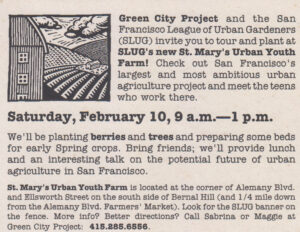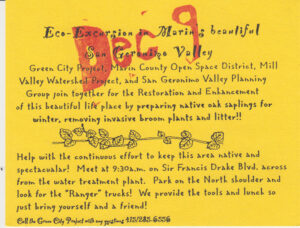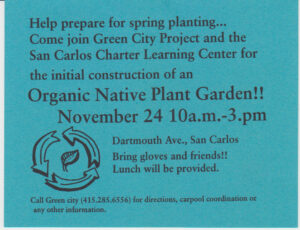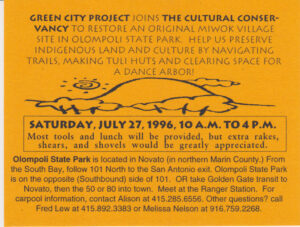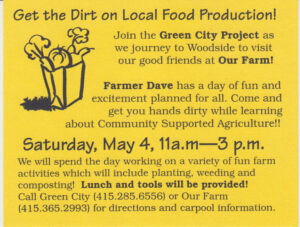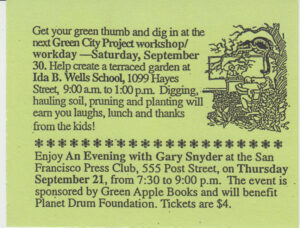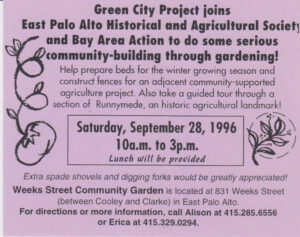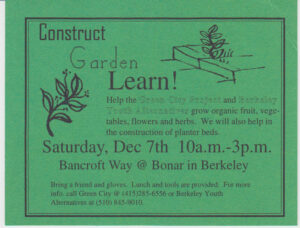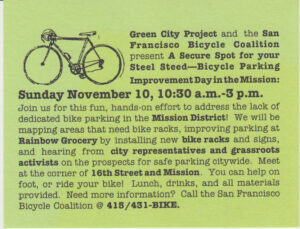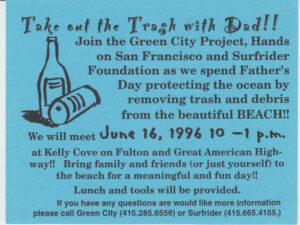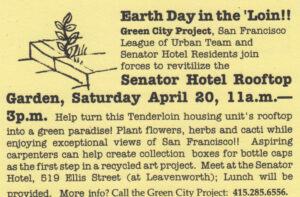Green City’s Workshop Workdays were geared toward empowering and improving the health of low-income, multicultural communities. Throughout the year, often monthly, Green City brought together community members and organizations concerned with common environmental issues for one-day Workshop Workdays. These work parties helped educate and activate diverse people and groups from around the Bay Area and left lasting benefits in the community.
Green City members received monthly postcards announcing Workshop Workday events and they were also listed in the Green City Calendar.
Timeline of Workshop/Workdays & Events—Carnaval, Rooftop Garden, Bottlecap Quilt, Eco-Art Contest
1992
1993
Carnaval Earth Block/Ciudad Verde
Paying Tribute to Mother Earth by joining the circle of green activities
at Carnaval and around the Bay Area
Every block and and street in the city is part of the earth. Every time we eat some food , turn on a water faucet or flip the light switch , we join in a shared circle with all the life on the planet. Earth Block/Ciudad Verde makes this basic reality visible. In keeping with Carnaval 1993’s theme “Tribute to Mother Earth” there are more than two dozen displays by groups that respect and help maintain the health of the earth. They have come to show our connection in the city to the ocean, forests, air and plants and animals. Whether ecolocy action groups or government agencies they have all worked with Planet Drum Foundation’s Green City Project to create presentations that are engaging and entertaining in the spirit of Carnaval. Hands-on demonstrations , native species, costumes, giveaways and bilingual Spanish/English fliers help to point out what environmental problems exist and what people can do about them…
—Peter Berg
Carnaval —Earth Block/Ciudad Verde 1993
Carnaval—Earth Block/Ciudad Verde 1993 Planet Drum
1994
During 1994 Green City coordinated seven collaborative Workshop/Workday projects which forged links between groups and communities, served as model projects, and provided skills for people to start and continue their own projects. Neighborhood Workshop/Workdays are geared toward empowering and improving the health of low-income, multicultural communities. This year educational workshops and physical work parties were at:
- The Senator Hotel (Tenderloin District , SF) Urban [rooftop] Gardening
- The Exploratorium (Palace of Fine Arts, SF) Clean-up and Habitat restoration
- Earth Block/ Ciudad Verde at Carnaval (Mission District, SF) Celebrating Life-Place Vitality. The Coordination of Earth Block/ Ciudad Verde, a block long section of over two dozen hands-on, bi-lingual, interactive environmental exhibits which educated and entertained approximately 50,000 people, including many children.
- Booker T. Washington Community Center/Western Addition Youth Action Center (Western Addition District, SF) Urban Gardening. Almost every youth at the Western Addition Youth Action Center had some part in the clean-up, construction, soil-moving and amendment, planting, and maintenance of this summer-long youth education project which resulted in a permanent garden site and community hub.
- The Marina District (SF) Water Resource Protection. Storm Drain stenciling with Wells Fargo employees.
- 24th Street Clean-up (Mission District, SF) Neighborhood Empowerment and Clean-Up.
- Seminary Creek (Oakland ) Habitat Restoration “We Mean Clean Creek Clean-up Day” at seven sites in Oakland resulting in the removal of eight tons of trash from inner-city creek riparian areas.
1995
This was the third year that Green City coordinated the environmental component of Carnival, Earth Block/ Ciudad Verde, San Francisco’s annual Memorial Day Weekend Celebration, which takes place in the Mission District and is attended by over half a million people. At least 50,000 people stopped at two dozen interactive environmental booths. Carnival is the largest multicultural festival on the West Coast and is an extremely imprtant forum for educating and interacting with diverse residents of the San Francisco Bay Area.
Since 1992 Workshop Workdays have served as an important means for bring the Volunteer Network and neighborhood groups together to help communities accomplish specific environmental tasks. Green City began doing regular monthly, collaborative work parties in July 1995. In addition to receiving a free lunch for their hard work, volunteers are able to participate in widely varying, ongoing environmental projects in many Bay
Area locations. In 1995 Green City helped organize the following education workshops and work parties:
- Open Space/Toxic Waste Bike Tour of the San Francisco Bay shoreline with the S.F. Bicycle Coalition and Greenbelt Alliance on July 29th. The ride was attended by over 70 people who learned about Mission Bay and other development plans, local Superfund sites, and how community action can catalyze change. We installed a bicycle rack at the Mission Rock Resort to encourage the use of alternative transportation.
- Educational Hike and Fennel Removal with San Bruno Mountain Watch in Brisbane on August 27th. Twenty volunteers helped to remove invasive fennel which squeezes out native plants that are necessary habitat for the Mission Blue butterfly, an endangered species that is found only on San Bruno Mountain.
- School Garden Creation at Ida B. Wells School in San Francisco on September 30th and October 14th. More than 50 volunteers, including students, teachers, neighbors, Youth in Action, and local businesses, helped to create a two-tiered terraced garden on the school campus which is being used cooperatively by classes and neighbors.
- Creek Restoration with EcoCity Builders at Berkeley’s Cordornices Creek on October 28th. Through our Green City Calendar and this special Workshop/Workday the GCP has played a significant role in helping to “daylight” this creek which had been running underground in a storm drain sewer. Richard Register of EcoCity Builders said “To date 268 volunteers have contributed labor valued at over $28,000 in construction/landscaping wages equivalent. The Green City Calendar was probably the second most important source of our volunteers.”
- Community Garden Building in San Francisco’s Mission District on November 11th with Dolores Street Community Services, Dolores Street Baptist Church, Youth in Action, San Francisco League of Urban Gardeners, Columbia Park Boys Club, and CISPES. Over 60 volunteers participated in this ”garden-raising” which resulted in creating a new community garden in one day! There is a long waiting list to join a community garden, so this site is sorely needed. A great article featuring the workday appeared in the next day’s Sunday issue of the San Francisco Chronicle/Examiner.
- Habitat Restoration in Marin County’s San Geronimo Valley on December 9th with San Geronimo Valley Planning Group, Mill Valley Watershed Project and Marin County Open Space District. Nearly 40 volunteers helped to “wean” four-year-old oak trees from their irrigation system, prepare younger oak samplings for winter, pick-up trash, and remove invasive Scotch broom.
- Earth Block/ Ciudad Verde at Carnaval (Mission District, SF) Celebrating Life-Place Vitality. The Coordination of Earth Block/ Ciudad Verde, a block long section of over two dozen hands-on, bi-lingual, interactive environmental exhibits which educated and entertained approximately 50,000 people, including many children.
1996
In 1996, Green City helped to organize the following educational workshops and work parties:
- January, Albany Hill – Green City revisited the site of a former workday collaboration and, despite the hindrance of rain, with Friends of Albany Hill led more than 20 volunteers in removing invasive ivy from a native oak grove. Later a botanist lead the group on a biological exploration of the Hill’s treasures.
- February, St. Mary’s Urban Youth Farm – Green City volunteers and SLUG (San Francisco League of Urban Gardeners) worked together building a retaining wall from waste concrete block, leveling a space for a composting/chipping site, and weeding and trenching around baby fruit trees.
- March, Spiral Gardens’ 59th Street Community Garden – Green City journeyed to the East Bay for a workday in Oakland. About 30 volunteers harvested nearly three cubic yards of prime worm compost from seven churning worm bins, and cleared and reorganized the entire compost and meeting area. (This garden was previously a vacant lot. Spiral Gardens specializes in “guerrilla gardening” take-overs.)
- April, Senator Hotel – Youth and adult residents, neighbors, members of the YMCA and several environmental groups joined forces to upgrade the rooftop garden at this low-income housing unit in San Francisco’s Tenderloin District.
- May, Our Farm – Participants learned about community supported agriculture in this beautiful South Bay farm while turning compost piles, planting seedlings and digging an irrigation ditch.
- May, Carnaval – Green City Project coordinated its fourth annual Earth Block/Ciudad Verde on May 26-27 as part of Mission Economic and Cultural Association’s (MECA) Carnaval celebration. Once again, thousands of Carnaval attendees were amazed, inspired and educated by over two dozen bilingual and interactive exhibits presented by local environmental non-profits groups. Highlights included compost bin demonstrations, mural art projects and – and for the first time – special entrance portal banners designed by a talented local graffiti artist! Sixteen local businesses provided financial support for this environmental education effort.
- June, Father’s Day Beach Clean-up – Twenty volunteers along with members of the Surfrider Foundation and Green City Project came to tidy-up Ocean Beach. Over 20 bags of trash and four bags of recyclables were filled and removed that day.
- July, Olompali Miwok Village Restoration — A presentation was given by a native Miwok about Miwok culture and conservation practices and then twenty volunteers made tule rope and helped clear space for a dance arbor.
- August, Bottle Cap Quilt Project – Senator Hotel residents, Green City Project, and reuse artist Remi Rubel collected bottle caps from local bars for the construction of a bottle cap quilt. Rubel and residents then met weekly to assemble a fantastic “trashformation” quilt. Its design illustrates what “home” means to the Hotel’s residents, all of whom are formerly homeless adults and families. The quilt was unveiled in August and now hangs in the lobby of the hotel. As part of this project residents visited the garbage transfer station and initiated a recycling program in the hotel.
- September, East Palo Alto Community Garden – Approximately 30 people attended this gardening day and were given a tour of the area by Trevor Burrows from the East Palo Alto Historical and Agricultural Society. The neighbors were very friendly and on four different occasions came out to talk and tell us their own personal history in the neighborhood.
- October, Native Plant Restoration on San Bruno Mountain – Over 1,000 native plants were planted on a site of more than 5 acres from which a Eucalyptus grove had been removed.
- November, Mission District Bike Improvement Day – Working with the San Francisco Bike Coalition, volunteers surveyed areas in the Mission to determine where there needs to be better bike parking. After surveying, everyone met at the Rainbow Store and installed 3 bike racks at the front entrance.
- November, San Carlos Charter School Native Plant Garden Creation – At this gardening day, volunteers built raised planter beds and created a 25×10 foot native plant garden.
- December, Garden & Green House Construction with Berkeley Youth Alternatives – More than 40 volunteers attended and learned about Berkeley Youth Alternatives and Green City and then took a walking historical tour of the beautiful gardens. Then they made bricks, from dirt and gravel, for the greenhouse floor dug trenches for new raised planter beds and tended to the compost piles (adding to them and turning and distributing the compost.)
1997
Besides these Workshop/Workdays and events, Green City began research and discussions with the South East Alliance for Environmental Justice to produce an EcoArt contest/event.
- January, Calendar Kiosk-Making Workparty at Mission Cultural Center – Green City gathered volunteers for a Calendar Kiosk-Making Workparty. The Mission Cultural Center provided a space to work. SCRAP provided recycled materials, and Green City Staff and friends created kiosks to display Green City Calendars.
- February, Native Plant garden Restoration at Washington High School – GCP teamed up with Washington High School to revitalize the school’s giant native plant teaching garden. Educator Emil Fogarino discussed the importance of native plants in urban gardens and gave a brief history of the project. It was a seminal event that brought together more than 50 volunteers.
- March, Rooftop Gardening & Compost Education at Vistacion Valley Middle School – Green City worked with Vistacion Valley Middle School on worm composting bins and a rooftop garden.
- April, Earth Day Rooftop Garden Party & Spring Planting Celebration at Community Housing Partnership’s Senator Hotel – Green City volunteers returned to the Senator Hotel in San Francisco’s Tenderloin District to work on the existing rooftop garden and to build a new parking lot garden. After several hours of hard work, residents and volunteers gathered for food and accordion music on the Senator’s roof.
- May, Bioregional Mapping Education Workshop at Watershed Poetry Festival – Green City Project helped sponsor the Watershed Festival of Poetry, Music & the Environment produced by Poetry Flash Magazine in Golden Gate Park.
- June, Stadium to Stadium Bicycle Tour along San Francisco’s Bayshore – Former Green City Project coordinator, Sabrina Merlo led the second annual Stadium to Stadium Bicycle Tour of San Francisco’s Bayshore Frontier. This 15-mile ride from the Caltrain Station to Candlestick Park, co-sponsored by the S. F. Bike Coalition, included discussions about proposed stadium plans, toxic pollution and environmental justice. Participants also enjoyed the gorgeous vistas and experienced the hidden wilderness of San Francisco’s post-industrial waterfront landscape.
- June, Green City Sustainability Shindig at Dolores Park – The first Green City Sustainability Shindig was held in Dolores Park, an open-air informational fair involving members, interested community residents, and variety of Volunteer Network organizations.
- August, Rooftop Garden Construction Workday at St, Cristina Residence Hotel — The Green City Project completed its second rooftop garden project in San Francisco’s Tenderloin District at the St. Cristina Residence Hotel located in the heart of downtown San Francisco on Market Street. (Thanks to Levi Foundation, Green City was able to provide stipends to residents who worked on the Garden.) First the St. Cristina residents went on a Rooftop Garden tour as part of garden planning. Then after a weekend’s work putting planter garden boxes together, some 30 volunteers came out to haul soil and native plants to the roof of the building. Nearly 10 cubic yards of soil later, the garden was completed and celebrated by all involved. Residents at the building were extremely excited and are looking forward to planting native wildflower seeds when the rains begin.
- October, Native Plant Garden Planning Workshop with St. Joseph’s School Community – Green City Project hosted a school and community garden design workshop at St. Joseph, the Worker School in Berkeley. Working together, several native plant and garden design experts, twenty-five parents, teachers and community members brainstormed ideas for the garden and discussed the materials necessary to complete this pioneering project. Lisa Stephens from People’s Park, in Berkeley, also gave an overview of restoration effort in the East Bay and how this project will fit into the continuing efforts to create, maintain and link wild areas.
- November Native Plant Garden Construction Workday at St. Joseph’s School in Berkeley – Green City Project completed the huge native plant garden at St. Joseph, the Worker School in Berkeley. A group of sixty parents, teachers and community members tore up nearly 2,000 sq. ft. of asphalt and replaced it with 40 cubic yards of new soil, a special outdoor classroom for students, and dozens of young native plants. Thanks to the tremendous efforts on the part of the staff, teacher Martin Scanlan, plant advisor Amanda Rieux, and all of the parents involved, the project was completed in a single weekend. Green City will be hosting an opening celebration for the garden on January 30th.
- December, Franciscan Wildlife Corridor Tour & Walk from John McLaren Park to San Bruno Mountain – Green City Project teamed up with the Franciscan Wildlife Corridor Alliance to sponsor “A Walk on the Wild Side: A Tour of the Francisca Wildlife Corridor.” Some twenty-five people walked the proposed corridor, learned local natural history, and discussed ways of making urban wildlife corridors a reality. David Graves, from Friends of McLaren Park and Katie Bode, a naturalist from SF State University, offered a wonderful view of the wilderness in our city.
1998
- Dr. Charles Drew Elementary School Earth Day refurbishing, San Francisco
- California Poppy seed harvesting, San Francisco
- Workday at Our Farm CSA, Woodside
- Bioregional Workshop and Urban Wild Exploration
- A Spring Equinox Celebration
- Delivery of soil for gardens at Edna Brewer Middle School, Oakland
- Delivery of soil to supplement rooftop gardens at the Senator Hotel, San Francisco
1999
- Ecoart Teacher Workshop, San Francisco: January
- Spring Seed planting at Our Farm CSA, Woodside: March
- Walk on The Wild Side in McLaren Park, San Francisco: April
- Garden Workday and Picnic at Burt Children’s Center, San Francisco: May
- Eco-Art Contest Party at Somarts Gallery, San Francisco: October
- Bioregional Mapping Workshop at Sonoma State Lifelab Garden, Rohnert Park, Sonoma County:

